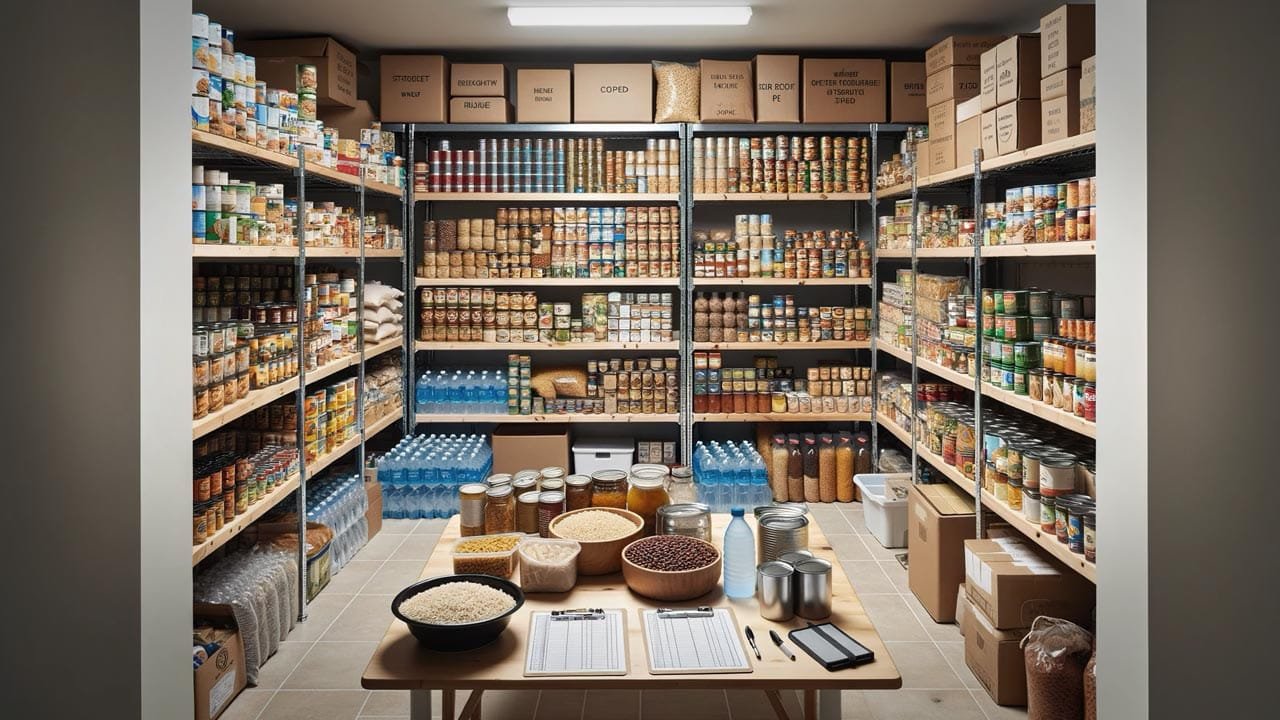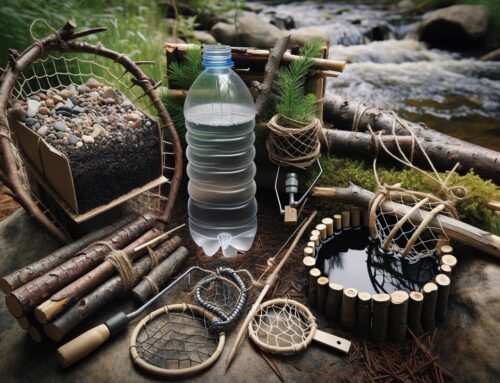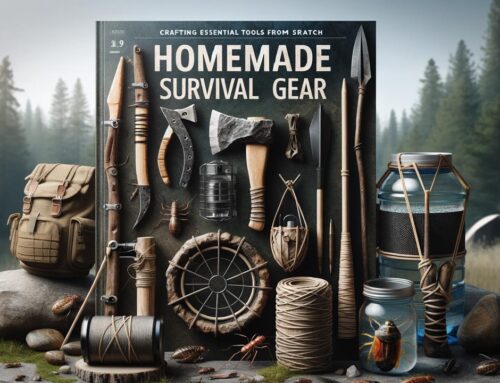Stocking Up for Long-Term Survival
In today’s unpredictable world, the concept of long-term survival has become increasingly relevant. Whether facing natural disasters, global pandemics, or other unforeseen emergencies, being prepared is not just prudent, it’s essential. Stocking up for long-term survival involves more than just accumulating supplies; it requires thoughtful planning and understanding of one’s specific needs. This guide delves into the critical aspects of building a survival stockpile, focusing on food and essential resources. It’s designed to equip you with knowledge and strategies to sustain yourself and your loved ones during extended periods of crisis, ensuring peace of mind in uncertain times.
Table of Contents
- Understanding Your Stockpile Needs
- Essential Food Items for Long-Term Survival
- Building a Comprehensive Stockpile
- Stockpiling Strategies and Tips
- Managing Your Stockpile
- Adapting to Different Survival Scenarios
- Frequently Asked Questions
- Conclusion
Understanding Your Stockpile Needs
Understanding your stockpile needs is a critical first step in preparing for long-term survival. It’s not just about accumulating random supplies; it’s about thoughtful planning based on realistic scenarios and personal requirements. Here are key considerations:
- Duration of the Stockpile: Assess how long you need your supplies to last. While emergency services recommend a 3-day minimum, situations like natural disasters, pandemics, or extended power outages can require much longer. Evaluate your circumstances to determine if you need a stockpile for weeks, months, or even a year.
- Caloric Requirements: Calculate the daily caloric needs for each person. This varies based on factors like age, gender, activity level, and health conditions. In survival situations, energy expenditure might increase due to physical strain or stress. Plan for at least 2000-2500 calories per day per adult, adjusting as necessary for children or special health needs.
- Nutritional Balance: A well-rounded diet is crucial for maintaining health. Your stockpile should include a variety of food groups, ensuring access to essential vitamins, minerals, and macronutrients. Consider special dietary needs or restrictions within your family, such as food allergies, vegetarian or vegan preferences, or medical conditions requiring specific diets.
- Food Preferences: Stock foods that are familiar and preferred by your family. In times of stress, familiar foods can provide comfort. However, balance this with the nutritional value and shelf life of the food items.
- Water Supply: Water is a critical component of your stockpile. Plan for at least one gallon per person per day for drinking and sanitation. Remember that needs may increase in hot climates or with increased physical activity.
- Storage Space and Conditions: Evaluate your available space and storage conditions. Some items require specific temperatures or protection from light and moisture. Efficiently utilizing space and ensuring proper conditions can greatly extend the life of your stockpile.
By carefully considering these aspects, you can create a stockpile that is tailored to your specific needs, ensuring that you and your family are prepared for various survival scenarios.
Essential Food Items for Long-Term Survival
Essential food items for long-term survival are the cornerstone of any effective stockpile. Selecting the right types of foods ensures not only sustenance but also the maintenance of health and well-being during extended periods of crisis. Key categories include:

- Top Shelf-Life Foods: Focus on foods with long shelf lives to ensure your stockpile remains viable over time. Staples like white rice, dried beans, canned tuna, and honey are renowned for their extended shelf-life. Including foods that retain their nutritional value and remain edible for years is crucial.
- Detailed Food Selections:
- Carbohydrates: Carbs are crucial for energy. Stock items like wheat flour, rice flour, quinoa, and various types of pasta. Remember, whole grains like brown rice have a shorter shelf life due to their oil content.
- Proteins: Proteins are essential for muscle repair and overall health. Include a variety of canned meats, beans, nuts, and powdered milk. These items offer longevity and versatility in meal preparation.
- Healthy Oils: Oils are vital for cooking and provide essential fatty acids. Stock up on items with longer shelf lives like olive oil, coconut oil, and flaxseed oil. Remember, most oils have a limited shelf life, so consider quantity and storage conditions.
- Snack Foods and Beverages: Medium and long shelf-life snacks like popcorn, rice cakes, and granola bars can be vital for quick energy boosts and morale. Additionally, beverages such as tea, coffee, and powdered drinks offer comfort and variety in your diet.
- The Role of Freeze-Dried Foods: Freeze-dried foods are an excellent addition to any long-term survival kit. They are lightweight, compact, and have an extended shelf life. These foods retain most of their nutritional value and can be rehydrated easily, making them an efficient and practical choice for long-term food storage.
By focusing on these essential food items, you can ensure that your long-term survival stockpile is diverse, nutritious, and capable of sustaining you through various emergency situations.
Building a Comprehensive Stockpile
Building a comprehensive stockpile for long-term survival is a multi-faceted process that requires careful planning and execution. It’s not just about accumulating a large quantity of food and supplies but about creating a balanced and sustainable resource that can support you through various emergency scenarios. Here are some critical steps and considerations:

- Assessing Personal and Family Needs: Start by evaluating the specific needs of your household. Consider dietary restrictions, medical requirements, and personal preferences. This assessment will help you tailor your stockpile to suit your unique situation, ensuring that everyone’s needs are met.
- Diversifying Food Types: A well-rounded stockpile should include a variety of food types. This includes grains, proteins, fruits, vegetables, dairy alternatives, and essential fats. Variety is key not only for nutritional balance but also for maintaining morale and preventing palate fatigue during extended periods of reliance on the stockpile.
- Focus on Non-Perishables and Long Shelf-Life Items: Choose foods that have a long shelf life and require minimal refrigeration. Items like dried beans, rice, canned goods, and freeze-dried meals are ideal. However, don’t neglect the inclusion of some perishable items that can be consumed in the early stages of an emergency.
- Water Storage and Purification: Water is essential for survival. Store enough water for drinking, cooking, and basic hygiene. Additionally, have a means to purify water, such as purification tablets, filters, or boiling methods, in case your stored supply runs low.
- Creating a Rotational System: Regularly rotate your stockpile to ensure that nothing expires or goes to waste. Use and replace items systematically, keeping an eye on expiration dates and storage conditions.
- Storage Solutions: Utilize efficient storage solutions that protect your supplies from environmental factors like moisture, light, and pests. Utilize space effectively, considering options like shelving, vacuum-sealing, and Mylar bags with oxygen absorbers for extended shelf life.
- Emergency Cooking Methods: In the event of power loss, alternative cooking methods are essential. Stockpile resources like propane stoves, solar ovens, or even simple fire-starting tools for cooking without electricity.
- Supplemental Supplies: Besides food and water, include other essential items like first aid kits, medications, hygiene products, and tools.
By methodically building and managing your stockpile, you can ensure that you’re well-prepared for a range of long-term survival scenarios, providing security and peace of mind for you and your loved ones.
Stockpiling Strategies and Tips
Developing effective stockpiling strategies and tips is crucial for ensuring your long-term survival supplies are well-managed, accessible, and sustainable. Here are essential strategies to consider:
- Use of Mylar Bags and Oxygen Absorbers: To prolong the shelf life of stockpiled food, use Mylar bags in combination with oxygen absorbers. This technique significantly reduces the presence of oxygen, which can degrade food quality over time. Properly sealed, these bags can preserve food for years.
- Prioritizing Water Storage: Water is a critical resource, often more important than food. Stockpile at least one gallon of water per person per day, and consider increasing this amount in hot climates or for high-activity scenarios. Store commercially purified water or purify and rotate tap water every few months.
- Investing in Cooking and Eating Utensils: In addition to food and water, ensure you have the necessary tools for cooking and consuming your stockpile. This includes pots, pans, utensils, manual can openers, and durable dinnerware. These items are often overlooked but are essential for utilizing your food stockpile effectively.
- Selecting the Right Can Sizes: Choose can sizes based on your family’s eating habits to minimize waste. Smaller cans are ideal for smaller families or single servings, while larger cans may be more suitable for bigger families or groups.
- Ration Packs for Long-Term Stockpiling: Reserve emergency ration packs for extended crises. These packs typically have a shelf life of up to five years and should be used when other food supplies have been depleted.
- Repacking and Labeling: Repack foods from original packaging into durable, airtight containers to protect against pests and environmental factors. Label each container with contents and expiration dates for easy identification and rotation.
- Choosing Easy-to-Prepare Foods: Stock foods that require minimal preparation, especially those that can be consumed with little to no cooking. This can be crucial in situations where cooking options are limited.
- Stockpiling for Special Needs: Consider the specific dietary requirements of your household, including allergies, intolerances, and preferences. This ensures everyone’s nutritional needs are met, even in survival situations.
By implementing these strategies, you can build a well-organized and effective stockpile, ensuring that you are well-equipped to handle various long-term survival situations with confidence and resilience.
Managing Your Stockpile
Effectively managing your stockpile is a critical aspect of long-term survival preparation. It involves more than just accumulating supplies; it requires ongoing attention and organization to ensure your stockpile remains useful and viable. Here are key aspects to consider:

- Regular Inventory Checks: Periodically review your stockpile to assess what you have and what might be missing or running low. Keeping an up-to-date inventory helps in planning and ensures you’re aware of your resources at all times.
- Rotation System: Implement a first-in, first-out (FIFO) rotation system for your stockpile. Use the oldest items first and replace them with newer ones. This practice is crucial for preventing food from expiring and ensures that your stockpile remains fresh and safe to consume.
- Maintaining Optimal Storage Conditions: Store your supplies in a cool, dry, and dark place to prolong their shelf life. Exposure to heat, moisture, and light can lead to spoilage and wastage. Proper storage conditions are vital for maintaining the quality and efficacy of your supplies.
- Managing Space Efficiently: Utilize your storage space effectively. Innovative shelving, stacking methods, and the use of vacuum-sealed bags can maximize space and keep your supplies organized and easily accessible.
- Regularly Updating Your Stockpile: As your family’s needs change due to factors like age, health, and lifestyle, update your stockpile accordingly. What was sufficient a year ago may not be adequate today.
- Emergency Access Plan: Ensure that your stockpile is easily accessible in an emergency. Having a clear and simple access plan can save valuable time when it matters most.
- Security Measures: In times of crisis, a well-stocked supply can become a target. Implementing appropriate security measures to protect your stockpile is essential.
- Practicing Using Your Stockpile: Periodically use items from your stockpile to familiarize yourself with their preparation and taste. This practice will help you make better choices about what to stock and ensure you are comfortable using these supplies if needed.
By managing your stockpile effectively, you can ensure that your preparations for long-term survival are practical, reliable, and tailored to your specific needs.
Adapting to Different Survival Scenarios
Adapting to different survival scenarios is a vital aspect of long-term preparedness. Each situation presents unique challenges and requires specific strategies for effective management. Understanding and planning for these variances can significantly increase your chances of thriving in any emergency. Here are key considerations for adapting to various scenarios:

- Urban vs. Rural Survival:
- Urban Environments: In densely populated areas, space for stockpiling might be limited, and reliance on community resources and services is higher. Focus on compact, high-calorie foods, and water purification methods. Developing a community network for resource sharing can be beneficial.
- Rural Settings: With more space, you might have the opportunity to grow food and raise livestock. However, access to external resources could be limited. Emphasize self-sufficiency, renewable resources, and skills like hunting and foraging.
- Natural Disasters vs. Prolonged Crises:
- Natural Disasters: These typically result in temporary disruptions. Stockpile should include items for immediate survival and recovery, such as first aid kits, clean water, and ready-to-eat foods.
- Prolonged Crises: In scenarios like economic collapse or severe pandemics, focus on a stockpile that supports long-term sustainability. This includes a larger variety of foods, seeds for growing crops, and tools for self-reliance.
- Shelter-In-Place vs. Evacuation:
- Shelter-In-Place: Have a well-rounded stockpile with a focus on comfort and normalcy. Include entertainment and morale-boosting items, especially for families with children.
- Evacuation: Prioritize portable supplies like lightweight food, water filters, and multi-purpose tools. Have a pre-packed “bug-out bag” for each family member.
- Seasonal Considerations:
- Adapt your stockpile and survival plan according to the seasons. In colder months, prioritize heating methods and warm clothing. In warmer seasons, focus on hydration and protection from heat-related illnesses.
- Energy and Power Outages:
- Prepare for scenarios without electricity. Stockpile alternative energy sources like solar chargers, batteries, and fuel for generators. Include non-electric cooking methods and entertainment options.
- Water Scarcity Situations:
- In scenarios where water is scarce, prioritize water collection and purification methods. Include items like rain barrels, water purification tablets, and solar stills.
By preparing for a range of scenarios, you can ensure that your survival strategy is robust, versatile, and capable of adapting to the unpredictable nature of emergencies.
Frequently Asked Questions
Conclusion
In conclusion, preparing a stockpile for long-term survival is a vital undertaking that requires careful planning, organization, and regular maintenance. It’s not just about gathering a mass of supplies; it’s about creating a well-rounded, sustainable resource that can support you and your loved ones in a variety of emergency scenarios. Remember, the key to effective stockpiling is not just in the quantity but in the quality and diversity of the supplies. Regularly assess and adapt your stockpile to meet changing needs and circumstances. By taking these steps, you can ensure peace of mind, knowing that you are prepared to face unexpected challenges with resilience and confidence. Embrace this journey of preparedness as an ongoing commitment to the safety and well-being of yourself and those you care for.







Leave A Comment